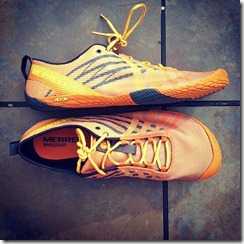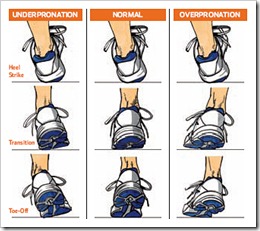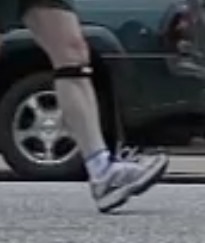
The goal of the study was to determine how heel striking vs. forefoot striking while running might alter: 1) lower back movement, 2) peak leg acceleration, 3) impact shock attenuation (i.e., how much shock is attenuated from the shin to the head), and 4) subjective comfort.
Methods
To address these questions, the researchers had 43 runners (24 male, 19 female) run barefoot on a treadmill using both a heel striking and a forefoot striking gait. Since 84% of the runners were heel strikers, in the vast majority of cases forefoot striking was a novel gait with which the runners had little or no experience. Shock was measured using accelerometers attached to the tibia and head, and lower back movement was measured using an electrogoniometer.
Results
Results of this study showed that running with a forefoot strike:
1) decreased total range of motion in the lower back, but did not alter peak flexion or extension
2) reduced peak tibial acceleration
3) reduced shock attentuation from the shin to head (since there was less shock to attenuate)
4) reduced subject running comfort
Commentary
One of my critiques of this paper is the manner in which they cued a forefoot strike. Here’s what they told runners to do: “1) ‘try to run on your toes’ and 2) ‘do not let your heels touch the ground.’”
This is not the typical way barefoot runners run (the heel almost always comes down after forefoot contact – see the video below from the NYC Barefoot Run), and is the same cueing applied in a previous study, which I wrote about in an article for Lower Extremity Review:
“…Laughton et al. found no significant difference in loading rates between rearfoot and forefoot strikers and increased tibial acceleration in forefoot-striking runners. However, they looked at natural rearfoot strikers asked to switch to a forefoot strike pattern rather than natural forefoot-striking runners, and, furthermore, they instructed runners to run with a “toe-strike” and not let the heel touch the ground. In my observation, natural toe running without heel contact is extremely rare among runners, and the authors point out that running with this style of gait could have caused artificial stiffening of the leg, leading to an increase in tibial shock.”
Interestingly, even though they advised runners to run in a similar manner, Delgado et al. actually found that tibial acceleration was lower in forefoot strikers in this case. This is the opposite of what Laughton et al. found, and I’d be curious to see the results if the heel were allowed to come since that would allow increased use of the ankle and calf musculature in shock absorption and could further reduce the need for movement at places like the knee, hip, and lower back.
Regarding the finding that adopting a FFS reduced overall back movement, they report the following:
“Greater overall low back excursion with a RFS pattern may suggest that this pattern creates a greater demand for stability in the lumbar spine. Therefore, this foot strike could possibly not be beneficial for individuals with stability problems, including hypermobility or atrophied lumbar spine musculature. However, the change in ROM did not exceed known error of the measuring device for lumbar ROM, suggesting that the effect may not be clinically significant even though it reached statistical significance.”
Thus, the results thus could indicate a positive effect of switching to a forefoot strike for those with lower back pain, but the difference was not of such a magnitude that they felt comfortable stating this with certainty (anybody experienced a reduction in lower back pain as a result of changing footstrike? – let us know in the comments). Again, it would be interesting to see if things might change with slightly different cueing and greater experience with a forefoot strike – it’s always difficult to know with instantaneous changes with a novel movement pattern will change with time. Following on the the latter point, the authors propose that the reason for the perception that heel striking while barefoot was more comfortable despite causing greater shock was because the forefoot strike was novel for most of the subjects (I can’t help but wonder if the advice “to run on your toes” was also detrimental to comfort – this style of forefoot striking puts a lot more strain on the calf muscles).
Finally, regarding impact shock they say the following:
“This study revealed that there was lesser peak leg impact at contact when running with a FFS pattern. This is consistent with current evidence suggesting that running with a FFS would decrease shock when compared to running RFS (6,29,31). Shock attenuation was also observed to be greater with RFS than FFS; there is more shock absorbed throughout the body when running RFS. This may be due to the overall greater foot-ground impact to be generated in RFS, thus increasing the magnitude of shock to be attenuated.”
So, like many other studies, this one shows that running barefoot with a forefoot strike reduces shock to the body relative to running barefoot with a heel strike. Not much surprise there, but another piece of evidence suggesting that if you plan to run barefoot, it may be best to avoid those heels!


















I did achieve dramatic reductions in lower back pain by switching to zero-drop, minimalist shoes. I think the most important factor was my work/casual shoes, as I spend much more time standing and walking at work or in casual shoes than I do running. Today I still get back pain in any shoe with more than a ~5mm heel lift. When I started running in minimalist shoes, without any instruction, I was “running up on my toes” as described in the study and immediately injured my Achilles tendon. In subsequent running, I aim for a forefoot landing and allow the whole foot to contact the ground.
Here’s my story. I was in a car accident and suffered a burst fracture at my T12 vertabra.
I should point out that up to this point I was not a runner.
3 months out of work, followed by part time work and PT 4x per week.
One day I was caught in the rain, and tried to run to my car. I was dressed in my normal work attire (no sneakers) and within 2 or 3 steps, the heel strikes shot pain up my spine to the point I was seriously worried I had re-broken my back. However the pain stopped as soon as I started walking.
About 2 weeks later I heard C.M. on NPR during the Born to Run publicity blitz and it just clicked. I read B2R and lots of other stuff on the web, I bought my first pair of VFF Sprints, and focused on a midfoot strike. NO PAIN IN MY BACK. Aside from TMTS type pains which were all muscular and not in my back, I have been very happy.Ok, I had a bout with shin splints and that sucked.
I still run in VFFs but have moved on to Bikilahs and Seeyas on roads and Merrell Trail Gloves off road.
My orthopedist told me most people with my level of breakage end up in wheelchairs. I just did my first marathon on 10/07.
Awesome, great story Rich!
—-
Pete Larson’s Web Links:
My book: Tread Lightly – link to ow.ly
Blog: https://runblogger.com
Twitter: link to twitter.com
Facebook: link to facebook.com…
Ruptured disc putting a lot of pressure on my spinal column (I think L5/S1). When it got symptomatic, I lost feeling and control of one leg below the knee (sounded like a pirate walking around) and couldn’t stand upright for several weeks. 2 months of physical therapy and full function was restored.
I started running again in traditional running shoes, 3x per week re-building a base. As soon as I broke the 6 mile run barrier, my back symptoms would return (never as bad thank you) and I would have to back off.
Like Rich, I read Born to Run, and started walking, then running in a pair of VFF Treks. Built my base running back to 4x per week, mostly on trails and running at various distances in the 3-10 mile range. This is the third summer since I injured my back and the symptoms have not returned since I started running exclusively in shoes that allow a forefoot strike pattern (I wear VFF Komodos on trails and a pair of low-drop performance trainers on roads).
I have no idea WHAT works, and at this point I’m not messing with a successful formula too much. The big changes after my back injury include: regular core building/stretching exercise at least 5x per week, more trail running, and transition to forefoot striking. Oh, and I run much slower now, but I blame my age.
You may be slower, but you’re running, and that’s what matters most! Thanks for sharing.
—-
Pete Larson’s Web Links:
My book: Tread Lightly – link to ow.ly
Blog: https://runblogger.com
Twitter: link to twitter.com
Facebook: link to facebook.com…
Hi Pete,
I have a herniated disc in my lower back. I recently just picked up running after 10 years of inactivity and still consider myself a newbie. I started off with walking in a traditional pair of Cross Trainer shoes. It gave me a lot of problem ranging from back pain to knee pain. I got so tired of it I went out to buy a new pair of shoes. I stumbled upon the Skechers GoRun purely by chance.
While picking up running with C25K plan, I was still a moderate heel striker and my landing wasn’t smooth at all and that really gives me lots of pressure on my lower back. I can feel it stiffening up after the training. As I got to the longer runs, my foot strike have started to move toward a midfoot/forefoot landing (Not too sure coz I can’t really see myself landing, but definitely not heel), my run felt smoother but I can still feel the impact travelling up to my back.
It is only when I concentrate on running smoothly, with a focus on soft landing that things click and the impact stops. Me think, it’s not just the foot strike pattern, but the running gait as well that will give you the overall results.
I would agree – short stride out front may be even more important.
—-
Pete Larson’s Web Links:
My book: Tread Lightly – link to ow.ly
Blog: https://runblogger.com
Twitter: link to twitter.com
Facebook: link to facebook.com…
I’ve had back problems most of my life. I had severe scoliosis that was treated with spinal fusion when I was 14. I’m 51 now. Over the years, I’ve had to give up my high impact activities, like running, tennis, softball, etc. About a year ago, I learned about barefoot running, and decided to give it a try. I still can’t run far. I’m up to about 30 minutes/5K, but I can run without back pain. I’m having problems with my hips & knees, but I suspect that’s arthritis. I have to be really smooth to get my joints to tolerate 30 minutes of running, and the only way I can do it is barefoot. BTW, I have a forefoot strike.
Glad you posted this, i have seen both types of forefoot striking and wasnt sure which was “right”.
A lot of people bend forward in their hips while they run. Just stand around like that for an hour or longer and your back will hurt!
Yes, anterior pelvic tilt is a problem for a lot of people, particularly those who spend their days sitting. Would be interesting to add hours sitting per day as a variable into a study like this.
—-
Pete Larson’s Web Links:
My book: Tread Lightly – link to ow.ly
Blog: https://runblogger.com
Twitter: link to twitter.com
Facebook: link to facebook.com…